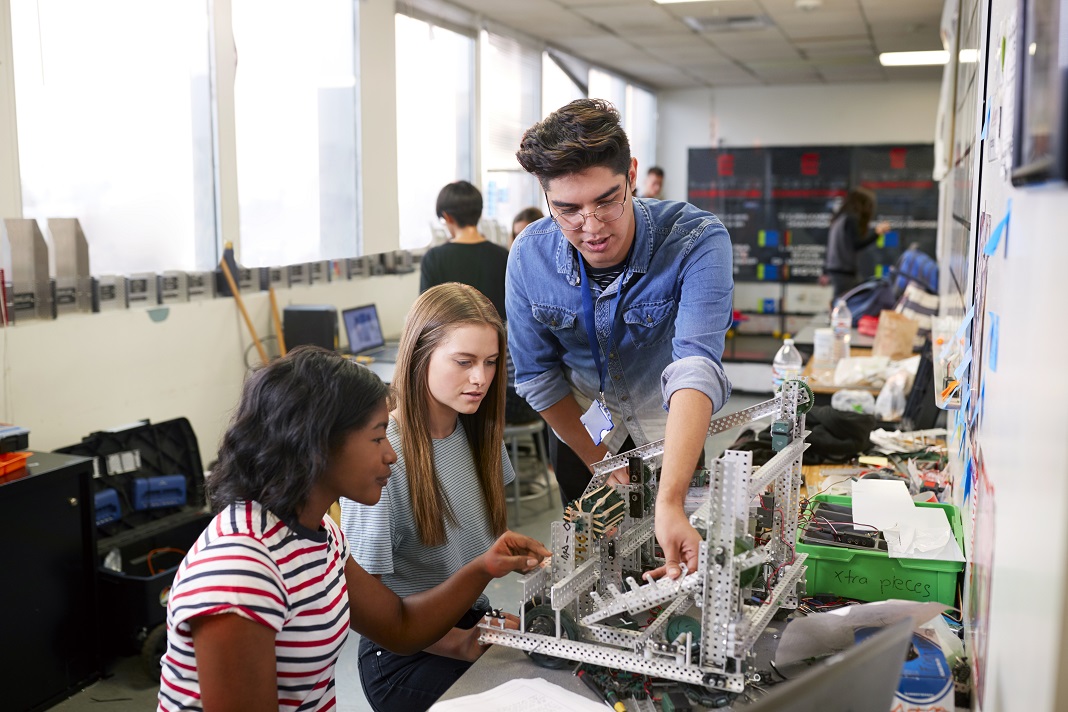Five Ways to Cultivate a STEM Culture in Schools
NMSI |
January 19, 2023
Teachers can’t do it all themselves — even though they often try. This is especially true when it comes to creating an immersive STEM learning experience.
The reality is that educators are most effective at bringing STEM to life for their students when they teach in a district with a commitment to forging a STEM-focused culture and leaders that provide the passion and resources needed to make it happen. STEM curricula by itself won’t get the job done.

Step-by-Step to STEM Ubiquity
“Successful schools provide a clear vision, a collaborative and supportive climate, and additional planning time for teachers,” according to “STEM-driven school culture: Pillars of a transformative STEM approach,” a 2022 report published by the Journal of Pedagogical Research.
Citing the book STEM Road Map: A Framework for Integrated STEM Education (Johnson, et al), the report’s authors (Carol C. Waters and Amy Orange) “concluded that school climate is developed through scheduled, collaborative efforts that allow teachers planning time and engaging with STEM experts.”
Let’s look at five things that can be done to nurture a productive STEM culture across an entire school or district:
Establish a vision, expectations and goals
It’s easy to have a vision for a STEM-permeated culture, but that isn’t enough. Administrators and teachers must have genuine expectations of success — not just for their students, but also for themselves as they undertake this immersion into science, technology, engineering and math.
System-level changes are critical to sustaining classroom gains. At NMSI, we work with school system leaders to build mindsets and practices focused on STEM education and inclusion.
Lead from the top and leverage peer leadership
One example from the Waters and Orange report describes teacher collaboration during a PLC meeting that led to mobile makerspaces and STEM bins that provide seamless integration of STEM curriculum throughout the school.
This resulted in teachers and students increasing interest, confidence, access and capacity for learning about STEM concepts and career opportunities. Teachers felt that interest and engagement during the classroom and EDP increased because of their interactions with the STEM bins prior to participating in the engineering STEM block week.
Demonstrate risk-taking and encourage mistakes
As educators, it’s important to model appropriate risk-taking behavior and share the mistakes we make when learning new skills. It’s vital that the classroom and district-wide culture goes beyond accepting mistakes to encouraging mistakes in the pursuit of expanding our minds and reaching for the stars.
One of our NMSI partner schools found success with taking this approach. Kashif Henderson, of Pittsburgh Public Schools said, “As we provide more awareness of what AP actually is and remove the stigma of fear, we’ve seen more students enroll in AP courses (including STEM) and continue throughout the entire year without dropping the class.”
Invite universal involvement
No one should be excluded from the opportunity to be a part of the STEM revolution. This includes the kitchen staff, custodians, office personnel, parents and anyone else who is a part of the school. Although they may not have direct roles in instruction, these stakeholders should be made aware of STEM initiatives and given opportunities to participate.
It doesn’t need to create a significant amount of extra work, but students can learn about science and nutrition with in-house field trips to the cafeteria or discover the role that math plays in certain office functions. When more people (adults and students) feel as if they’re part of a powerful initiative, it enriches the lives of everyone.
Provide quality, results-oriented professional development
Broad change doesn’t happen overnight or within a vacuum. Teachers need tools, training and other support needed to improve student outcomes. This also builds their confidence and demonstrates your appreciation for their dedication.
Providing access to evidence-based STEM professional development materials gives teachers the in-depth content and pedagogical knowledge that lead to increased STEM engagement and achievement. Professional development takes on many forms, with NSMI leading the way in support of educators.
.jpg.aspx)
STEM Education for All
A recent “STEM Education for the Future” report from the National Science Foundation (NSF) aligns with the focus on STEM culture: “To maximize the opportunity, we must consider the entire education ecosystem so that children of all backgrounds, race, ethnicity, gender, religion and income levels can learn the wonders and possibilities of STEM and maintain that interest and passion throughout their lives.”
As you evaluate your district’s STEM culture, you can turn to the STEM Framework for Success. This NMSI-led collaborative resource is a collection of 10 conditions, practices and outcomes that education and research experts agree help indicate how well a state, school system or school is performing in the delivery of STEM education. Each element of the Framework is measured by publicly available data, and visually reported through the STEM Opportunity Index.
NSF sums it up well, “Whether or not they become scientists or engineers, all Americans should have the access, opportunity, encouragement, and tools to participate in the innovation economy.” We agree and are here to help your district make it happen.